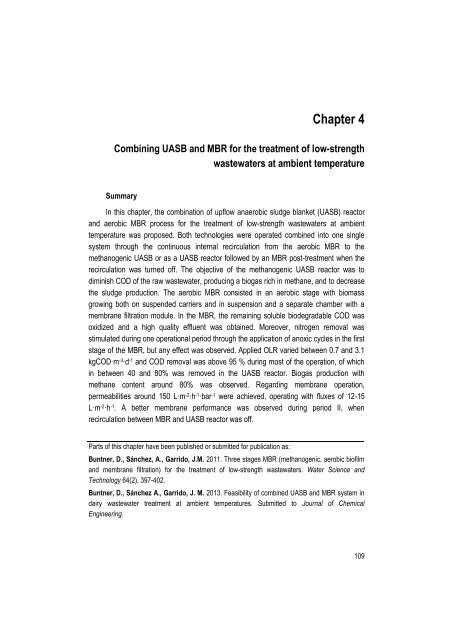Combining submerged membrane technology with anaerobic and ...
Combining submerged membrane technology with anaerobic and ...
Combining submerged membrane technology with anaerobic and ...
Create successful ePaper yourself
Turn your PDF publications into a flip-book with our unique Google optimized e-Paper software.
Chapter 4<strong>Combining</strong> UASB <strong>and</strong> MBR for the treatment of low-strengthwastewaters at ambient temperatureSummaryIn this chapter, the combination of upflow <strong>anaerobic</strong> sludge blanket (UASB) reactor<strong>and</strong> aerobic MBR process for the treatment of low-strength wastewaters at ambienttemperature was proposed. Both technologies were operated combined into one singlesystem through the continuous internal recirculation from the aerobic MBR to themethanogenic UASB or as a UASB reactor followed by an MBR post-treatment when therecirculation was turned off. The objective of the methanogenic UASB reactor was todiminish COD of the raw wastewater, producing a biogas rich in methane, <strong>and</strong> to decreasethe sludge production. The aerobic MBR consisted in an aerobic stage <strong>with</strong> biomassgrowing both on suspended carriers <strong>and</strong> in suspension <strong>and</strong> a separate chamber <strong>with</strong> a<strong>membrane</strong> filtration module. In the MBR, the remaining soluble biodegradable COD wasoxidized <strong>and</strong> a high quality effluent was obtained. Moreover, nitrogen removal wasstimulated during one operational period through the application of anoxic cycles in the firststage of the MBR, but any effect was observed. Applied OLR varied between 0.7 <strong>and</strong> 3.1kgCOD·m -3·d -1 <strong>and</strong> COD removal was above 95 % during most of the operation, of whichin between 40 <strong>and</strong> 80% was removed in the UASB reactor. Biogas production <strong>with</strong>methane content around 80% was observed. Regarding <strong>membrane</strong> operation,permeabilities around 150 L·m -2·h -1·bar -1 were achieved, operating <strong>with</strong> fluxes of 12-15L·m -2·h -1 . A better <strong>membrane</strong> performance was observed during period II, whenrecirculation between MBR <strong>and</strong> UASB reactor was off.Parts of this chapter have been published or submitted for publication as:Buntner, D., Sánchez, A., Garrido, J.M. 2011. Three stages MBR (methanogenic, aerobic biofilm<strong>and</strong> <strong>membrane</strong> filtration) for the treatment of low-strength wastewaters. Water Science <strong>and</strong>Technology 64(2), 397-402.Buntner, D., Sánchez A., Garrido, J. M. 2013. Feasibility of combined UASB <strong>and</strong> MBR system indairy wastewater treatment at ambient temperatures. Submitted to Journal of ChemicalEngineering.109
















